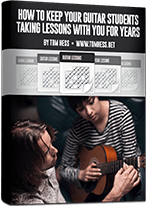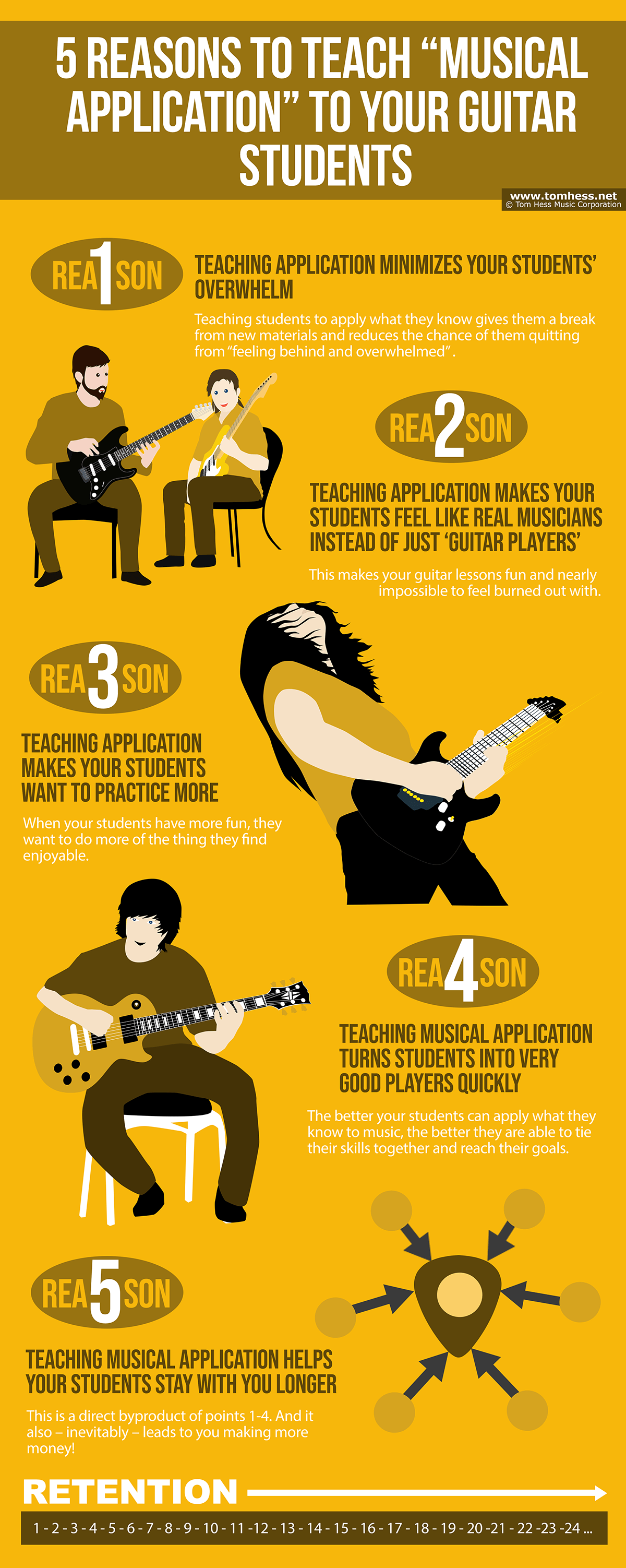The Guitar Teachers’ Guide to Teaching Musical Application

EMAIL TO GET ACCESS
By submitting your info, you agree to send it to Tom Hess Music Corporation who will process and use it according to their privacy policy.
In this article for guitar teachers, I’ll show you a guitar teaching skill that can help your guitar students to:
- enjoy taking guitar lessons from you way more
- become better players faster (as a result of your guitar teaching abilities)
- eagerly practice what you – their guitar teacher – tell them to practice
- tie their musical skills together and feel like real musicians instead of just guitar players.
- likely continue taking guitar lessons with you for years and refer many of their friends to become your guitar students.

EMAIL TO GET ACCESS
By submitting your info, you agree to send it to Tom Hess Music Corporation who will process and use it according to their privacy policy.
What is that guitar teaching skill?
I'm talking about teaching musical application to your guitar students.
That is something few guitar teachers know how to do (let alone - do well).
But those guitar teachers who do?
They tend to make a lot of money teaching guitar and never struggle to keep a full guitar teaching schedule.
Ready to start?
This is what you need to know about teaching musical application to your guitar students:

And here are the key steps to take when teaching musical application to your guitar students during your lessons:
Guitar Teaching Tip #1 For Teaching Musical Application: Teach Less – Train More
The #1 mistake to avoid when teaching guitar (that makes teaching musical application impossible) is burying your guitar students with new content.
This guitar teaching approach creates several problems:
- It makes your guitar students feel overwhelmed and powerless to keep up with the flow of new content you’re throwing their way when you’re teaching guitar to them.
This powerlessness makes many guitar students feel like learning guitar will demand more effort than they are willing to put forth.
- it makes lessons boring. Remember high school? Few students looked forward to hearing their teachers lecture at them every day during classes.
Well, guess what?
If you turn “teaching guitar to your guitar students” into a musical version of high school – it won’t be fun for them either.
- it doesn't motivate your guitar students to practice guitar at home. If too much guitar teaching = “high school”, then practicing the mountains of new information you’ve learned = “homework”.
This leads to the next problem, which is:
- When your guitar students can’t apply what they know, they tend to improve slower (since they put forth less effort into understanding or practicing your guitar teaching).
As a result of all this, your guitar students will tend to quit more often, making it harder for you to earn money teaching guitar.

Solution: Alternate moments of guitar teaching (presenting new information) with training your guitar students (watching them practice, correcting their practice habits)...
... and coaching them (giving them assignments on how to best use what you just taught them).
This “coaching” is the process through which you’ll be teaching musical application to your guitar students. (More on this below.)
Here is an example of what this aspect of teaching guitar could look like:
Question: “But Tom Hess, what if my guitar students object to me taking up their guitar teaching ‘lesson’ time (that they are paying for) with other activities besides “teaching”?”
Answer: Simply remind your guitar students that what they are paying you for isn’t to hear you talk or lecture to them like a high school teacher.
No – they are investing in your guitar teaching for you to help them get the results they want in their guitar playing.
Plus: to do it faster & easier than they are likely to get it on their own.
This way of training and coaching them is one of the ways you can ensure they are truly ‘getting’ what you are teaching them and will practice correctly at home.
i.e. it’s the closest thing to you being in the room with them while they practice between lessons and making sure they are practicing the right way.
When you say that, your guitar students will very likely not only stop complaining, but will respect you much more (for obviously caring about their guitar playing more than any other guitar teacher they’ve ever had).
Pro tip: remind your guitar students of this before you proceed teaching musical application to them (or training and coaching them in any way that is different to what they imagine).
It’s far easier to pre-empt this little objection to your style of guitar teaching ‘before’ it ever comes up than to try to change your guitar students’ mind after they are unhappy with something.
Guitar Teaching Tip #2 For Teaching Musical Application: Transfer ‘Content’ To A New ‘Context’
This – in a nutshell – is what teaching musical application is all about.
Taking something your guitar students learned to play (or do) on guitar (i.e. ‘content’... for example: a new guitar arpeggio) to a different musical context.
 Attract More New Guitar Students
Attract More New Guitar StudentsFind out how to become effective
at attracting new guitar students.
 Improve Your Guitar Teaching Biz
Improve Your Guitar Teaching BizDiscover how to make your guitar teaching business more succesful.
 Earn Good Money Teaching Guitar
Earn Good Money Teaching GuitarLearn 11 steps you should take to earn more money teaching guitar.
By “context”, I mean:
... a new tempo, harmony, rhythm, genre, texture, timbre or form of the song than the original context.
Show your guitar students how the way they’d play an arpeggio over a classic rock song would be very different than how they’d play it over a metal tune.
Better yet:
Challenge your guitar students to apply a guitar playing context to a musical context where they think it doesn't belong (or where they suspect it might sound bad).
When you (and your guitar students) can do that, you’ve succeeded at teaching musical application to them.
Case in point:
I was once teaching guitar to a guitar student of mine who loved Southern classic rock and blues.
Then, one year – at my annual HESSFEST live event – he asked me for help with applying arpeggios (of all things) to his guitar licks and guitar solos.
My other guitar students were eagerly watching, wondering what answer I could possibly give him.
Watch this video to see what happened:
And here is a specific guitar practice circuit you can use when teaching guitar to your guitar students (and specifically – when teaching musical application to them):
Guitar Teaching Tip #3 For Teaching Musical Application: Teach Musical Analysis To Your Guitar Students Vs. Teaching Them ‘Songs’
Most guitar teachers teach songs to their guitar students (i.e. how to ‘play the notes’) because they think that is what their guitar students want to learn.
In reality?
I believe teaching guitar ‘only’ via songs is what guitar teachers do when they lack REAL guitar teaching skills.
Because here is the thing:
Your guitar students don’t need you to learn songs. They can stay at home and find tab of songs online for free. (And those guitar teachers have only themselves to blame if they struggle to keep a full guitar teaching schedule.)
What guitar students CAN’T easily find is a guitar teacher who can show them:
- why the song sounds as cool as it does.
- how to use that understanding to create their own guitar riffs, songs and solos.
Guitar teachers who can teach this are rare.
And that’s also why guitar teachers who can teach this tend to make a lot more money teaching guitar than other teachers in their area.
Guitar Teaching Tip #4 For Teaching Musical Application: Train Your Guitar Students’ Musical Ear
Teaching ear training to your guitar students will help you (and your guitar students) become better musicians faster and apply what they are learning to real music.
Here are some of the ways to work on ear training with your guitar students when you are teaching guitar to them:
1. Have your guitar students transcribe (by ear) songs, chords, melodies and solos. Tailor this step to their skill level.
2. Train your guitar students sing (yes sing out loud) scales. Start with singing the major scale, later add the natural minor scale, harmonic minor scale, pentatonic scale, blues scale, etc.
3. Train your guitar students to sing intervals (two notes at varying distances)
4. Train your guitar students to sing arpeggios (chords - one note at a time) start with major triads and then move on to minor triads.
5. Transcribe music rhythms. This is just like transcribing a melody, but the focus here is on writing down on paper the rhythm only.
Guitar Teaching Tip #5 For Teaching Musical Application: Remind Your Guitar Students That They Are Never ‘Done’ Working On This Skill.
Yep.
Working on musical application isn’t something you do ‘once’... it ought to be a regular part of your guitar teaching.
And it ought to be a critical important part of your guitar students’ practicing.
This is important for you (the guitar teacher) to remember, so you can get all the reputation and income-boosting benefits teaching musical application has for your business.
And this is important for your guitar students to remember, so they get all the fun and progress-boosting benefits they get from training this ability.
Now that you know the secrets to teaching musical application, the next step to becoming more successful teaching guitar is to motivate your guitar students to take guitar lessons with you a lot longer.
I can help you with this in my free eGuide How To Keep Your Guitar students Taking Lessons With You For Years download it today and discover the guitar teaching success secrets most guitar teachers will never know.


Want to earn 6-figures teaching guitar part time? Learn how with the world’s most proven guitar teacher training.

